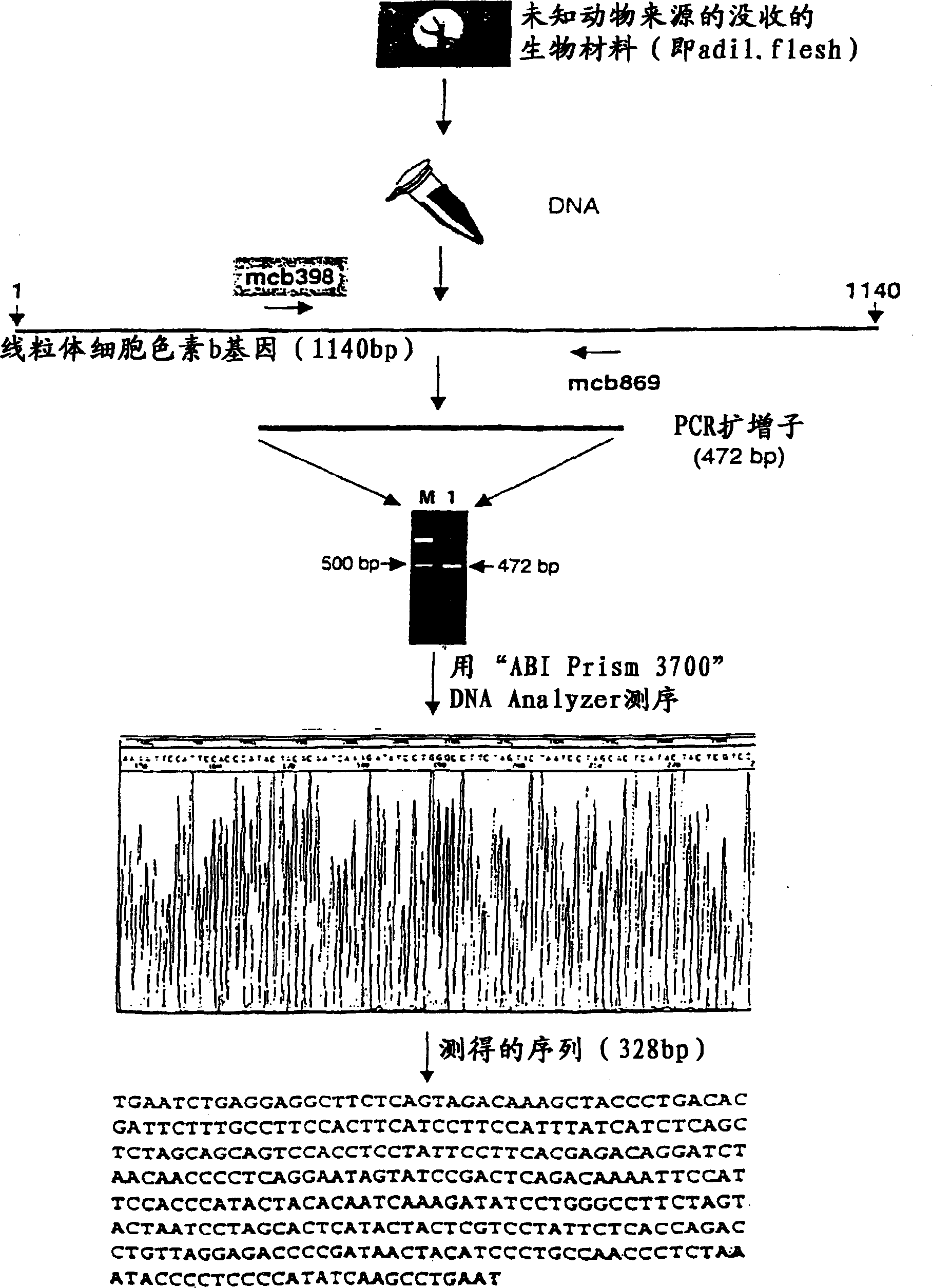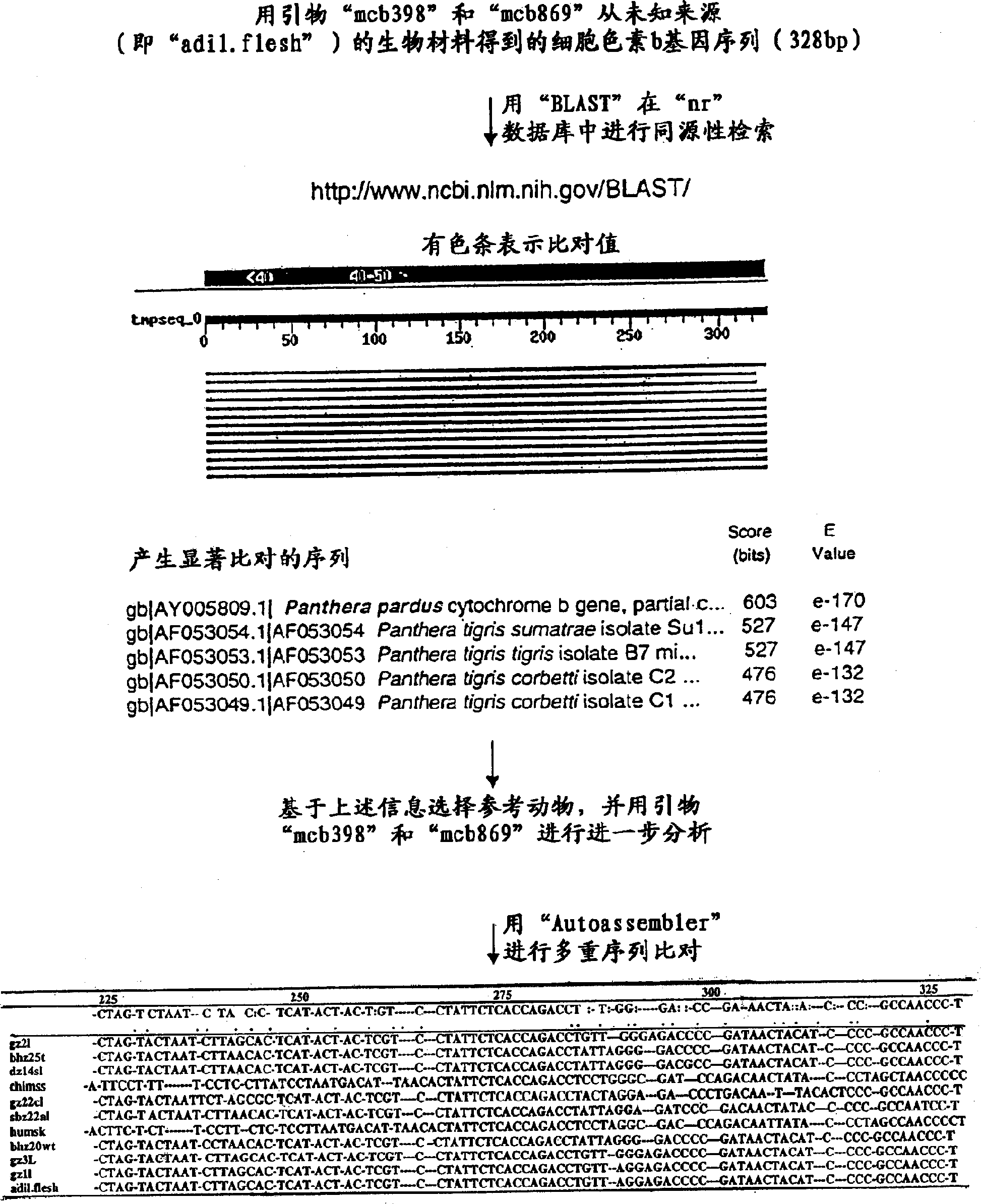Universal primers for wildlife identification
A technology for universal primers and biological samples, applied in the field of identification of new universal primers, can solve problems such as impracticality
- Summary
- Abstract
- Description
- Claims
- Application Information
AI Technical Summary
Problems solved by technology
Method used
Image
Examples
Embodiment 1
[0108] Examples of identifying cytochrome b gene fragments that meet the requirements in columns 1, 2 and 3 mentioned in the subheading 'Objective of the invention' in the heading 'Summary of the invention'
[0109] Mitochondrial cytochrome b molecules have been widely used in molecular taxonomy research. As a slowly evolving gene, it has enormous information in its nucleotide sequence that distinguishes the family, genus, and species origin of animals 1-65 . Extensive databases of cytochrome b gene sequences from different animal species have been accumulated in NCBI's nr and mito databases. We have exploited these properties of the cytochrome b gene to determine the family, genus and species origin of any confiscated remains of unknown animal origin. To this end, we have identified a segment of the cytochrome b gene that is highly polymorphic between species but monomorphic in individuals of the same species, thus allowing individuals of unknown species to be grouped with ...
Embodiment 2
[0119] Example of developing universal primers to amplify the fragments mentioned in 'Example 1' A pair of universal primers were designed with the following characteristics:
[0120] 1. It targets the identified fragments (mentioned in 'Example 1') and amplifies them in the polymerase chain reaction (PCR).
[0121] 2. Its 3' and 5' ends are highly conserved in a wide range of animal species (marked with an asterisk (*) in Table 2), thus ensuring amplification of the above-mentioned fragments in a generic manner. Sequencing of the amplified fragments with these primer pairs revealed a molecular signature of the species of the analyzed material, which molecular signature compared to the sequence of a known reference animal revealed the species identity of the unknown biological material being studied.
[0122] 3. The tm (melting temperature) of the two primers are almost similar (about 58 degrees Celsius), ensuring significant annealing of both primers to their template, and th...
Embodiment 3
[0132] Example of developing universal PCR conditions to ensure amplification of any template of unknown origin in PCR and thus enhancing the versatility of the technique invented by us
[0133] The developed PCR conditions have the following unique characteristics:
[0134] 1. These conditions enable the amplification of any animal derived DNA template in a universal manner with the universal primers mentioned in 'Example 2'.
[0135]2. The conditions were chosen to ensure comparable annealing temperatures for the two primers, 'mcb398' and 'mcb869'.
[0136] 3. The standardized PCR conditions are therefore universal; thus the probability of PCR failure on templates of unknown origin due to non-standard conditions is excluded. This ensures the versatility of our technique in wildlife forensics.
[0137] 4. The above general conditions are:
[0138] Amplification reactions should be performed in a 20 μl reaction volume containing approximately 20 ng of template DNA, 100 μm o...
PUM
 Login to View More
Login to View More Abstract
Description
Claims
Application Information
 Login to View More
Login to View More - R&D
- Intellectual Property
- Life Sciences
- Materials
- Tech Scout
- Unparalleled Data Quality
- Higher Quality Content
- 60% Fewer Hallucinations
Browse by: Latest US Patents, China's latest patents, Technical Efficacy Thesaurus, Application Domain, Technology Topic, Popular Technical Reports.
© 2025 PatSnap. All rights reserved.Legal|Privacy policy|Modern Slavery Act Transparency Statement|Sitemap|About US| Contact US: help@patsnap.com



